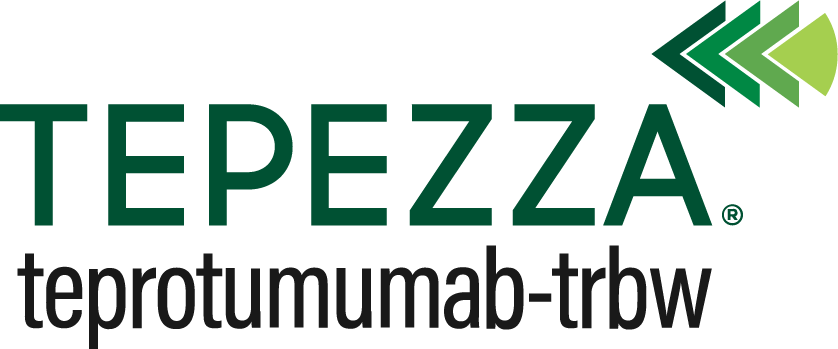Advertisement
|
Answers to your Questions about
Treating Thyroid Eye Disease (TED)
|
 |
TED is a serious, chronic autoimmune disease that can lead to long-term repercussions—it can worsen vision, potentially leading to optic neuropathy.1-3 TED is separate from Graves’ disease and is treated differently. TED is characterized by the following4
- Can present with a variety of signs and symptoms2
- Can reactivate or flare5,6
- May lead to psychosocial difficulties7,8
Due to its progressive nature, early intervention has been shown to reduce disease impact.1,2,9
TEPEZZA® (teprotumumab-trbw) is indicated for the treatment of TED. Things to remember before starting your patients on TEPEZZA:
- TEPEZZA is a specialty medicine and will require prior authorization by insurance
- TEPEZZA is an intravenous medicine, and a full course of treatment is 8 infusions10
- While some patients in the Phase 2 and 3 clinical trials experienced a reduction in proptosis, redness, pain, and swelling as early as 6 weeks after start of treatment with TEPEZZA, it is recommended that patients receive the full course of 8 infusions over a 24-week period10,11
See Important Safety Information on TEPEZZA below.

INDICATION
TEPEZZA is indicated for the treatment of Thyroid Eye Disease.
IMPORTANT SAFETY INFORMATION
WARNINGS AND PRECAUTIONS
Infusion Reactions: TEPEZZA may cause infusion reactions. Infusion reactions have been reported in approximately 4% of patients treated with TEPEZZA. Reported infusion reactions have usually been mild or moderate in severity. Signs and symptoms may include transient increases in blood pressure, feeling hot, tachycardia, dyspnea, headache, and muscular pain. Infusion reactions may occur during an infusion or within 1.5 hours after an infusion. In patients who experience an infusion reaction, consideration should be given to premedicating with an antihistamine, antipyretic, or corticosteroid and/or administering all subsequent infusions at a slower infusion rate.
Preexisting Inflammatory Bowel Disease: TEPEZZA may cause an exacerbation of preexisting inflammatory bowel disease (IBD). Monitor patients with IBD for flare of disease. If IBD exacerbation is suspected, consider discontinuation of TEPEZZA.
Hyperglycemia: Increased blood glucose or hyperglycemia may occur in patients treated with TEPEZZA. In clinical trials, 10% of patients (two-thirds of whom had preexisting diabetes or impaired glucose tolerance) experienced hyperglycemia. Hyperglycemic events should be controlled with medications for glycemic control, if necessary. Assess patients for elevated blood glucose and symptoms of hyperglycemia prior to infusion and continue to monitor while on treatment with TEPEZZA. Ensure patients with hyperglycemia or preexisting diabetes are under appropriate glycemic control before and while receiving TEPEZZA.
ADVERSE REACTIONS
The most common adverse reactions (incidence ≥5% and greater than placebo) are muscle spasm, nausea, alopecia, diarrhea, fatigue, hyperglycemia, hearing impairment, dysgeusia, headache, dry skin, weight decreased, nail disorders, and menstrual disorders.
Please see Full Prescribing Information or visit TEPEZZAhcp.com for more information.
References:
1. Bahn RS. Graves’ ophthalmopathy. N Engl J Med. 2010;362(8):726-738. 2. Patel A, Yang H, Douglas RS. A new era in the treatment of thyroid eye disease. Am J Ophthalmol. 2019;208:281-288. 3. Ugradar S, Kang J, Kossler AL, et al. Teprotumumab for the treatment of chronic thyroid eye disease. Eye (Lond). 2022;36(8):1553-1559. 4. Wang Y, Patel A, Douglas RS. Thyroid eye disease: how a novel therapy may change the treatment paradigm. Ther Clin Risk Manag. 2019;15:1305-1318. 5. Douglas RS, Kahaly GJ, Ugradar S, et al. Teprotumumab efficacy, safety, and durability in longer-duration thyroid eye disease and re-treatment: OPTIC-X study. Ophthalmol. 2022;129(4):438-449. 6. Patel P, Khandji J, Kazim M. Recurrent thyroid eye disease. Ophthalmic Plast Reconstr Surg. 2015;31(6):445-448. 7. Kahaly GJ, Petrak F, Hardt J, Pitz S, Egle UT. Psychosocial morbidity of Graves’ orbitopathy. Clin Endocrinol (Oxf). 2005;63(4):395-402. 8. Park JJ, Sullivan TJ, Mortimer RH, Wagenaar M, Perry-Keene DA. Assessing quality of life in Australian patients with Graves’ ophthalmopathy. Br J Ophthalmol. 2004;88(1):75-78. 9. Douglas RS, Kahaly GJ, Patel A, et al. Teprotumumab for the treatment of active thyroid eye disease. N Engl J Med. 2020;382(4):341-352. 10. TEPEZZA (teprotumumab-trbw) [prescribing information] Horizon. 11. Smith TJ, Kahaly GJ, Ezra DG, et al. Teprotumumab for thyroid-associated ophthalmopathy. N Engl J Med. 2017;376(18):1748-1761.
|
TEPEZZA and the HORIZON logo are trademarks owned by or licensed to Horizon.
© 2023 Horizon Therapeutics plc P-TEP-US-00804 01/23
|
 |